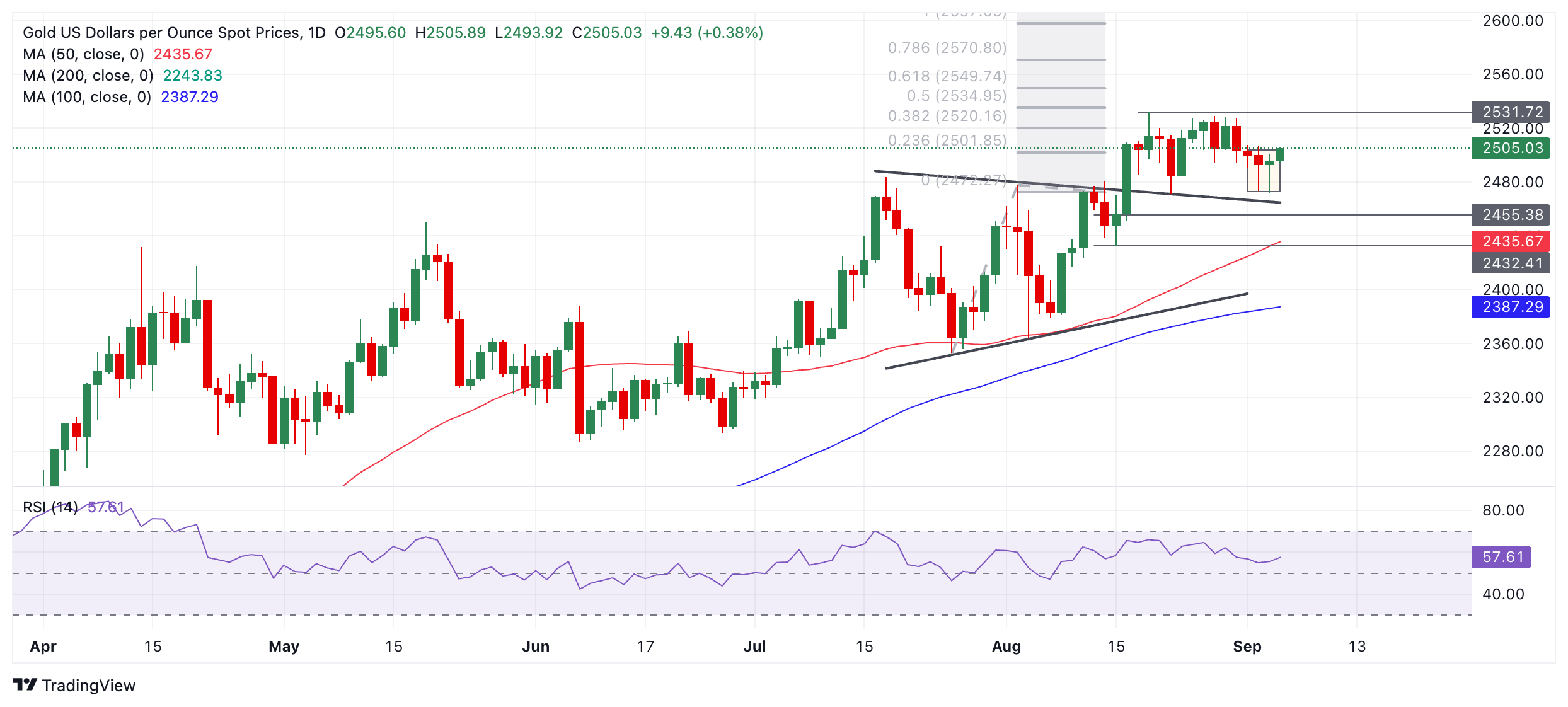Gold recovers to above $2,500 level after release of US job’s data

- Gold recovers after the release of under par US job’s data stokes fresh concerns about a hard landing.
- The probability the Fed will cut interest rates by half a percent at its September meeting rises to 45%.
- Technically, Gold forms two bullish Hammer candlesticks in a row, suggesting a chance of a recovery.
Gold (XAU/USD) trades back above $2,500 on Thursday after rebounding from the $2,471 previous day’s lows, following the release of lower-than-expected job openings data in July from the US, which stoked fresh hard-landing fears.
Gold price finds its feet after job’s data
Gold recovers after the release of weaker-than-expected US job’s data. This increased safe-haven demand for the yellow metal and implied interest rates could fall faster than previously anticipated in the US – another positive for Gold, as it reduces the opportunity cost of holding the non-interest-paying asset.
US JOLTS Job Openings fell to 7.673 million in July from a downwardly revised 7.910 million in June and below estimates of 8.100 million, according to data from the US Bureau of Labor Statistics on Wednesday.
The data feeds into the fragile US labor market narrative that is driving Federal Reserve (Fed) interest rate expectations after Fed Chairman Jerome Powell sounded the warning on jobs in his speech at the Jackson Hole Symposium last month.
It follows weak US manufacturing data on Tuesday, which triggered a global market flash crash that was further exacerbated by fears about the Artificial Intelligence (AI) tech bubble bursting.
From around 31% before the Manufacturing and JOLTS data, the probability of the Fed cutting interest rates by 0.50% at their September 18 meeting, rather than the standard 0.25%, has risen to 45%.
ADP Employment Change and Jobless Claims follow on Thursday, but the main event on the calendar will be US Nonfarm Payrolls (NFP) on Friday. If NFPs increase less than expected, it would further support the case of the larger rate cut.
Gold may also be rising after the World Gold Council (WGC) published data showing a rise in central bank Gold buying. Central bank Gold reserves in July rose by 37.6 tonnes, from -4.6 tonnes in June, according to data from the WGC report released on Tuesday. Central banks have become a major source of Gold demand in recent years and now account for roughly 18% of the market. The data did, however, also show that the People’s Bank of China (PBoC) continued its halt on Gold buying in July after stopping purchases in May.
On the geopolitical front, Reuters reports that US negotiators are preparing another ceasefire deal in Gaza whilst the war in Ukraine continues unabated.
Technical Analysis: Two Hammer candlesticks in a row could signal recovery
Gold (XAU/USD) posts two bullish-looking Japanese Hammer candlesticks in a row (box on the chart below), and if Thursday closes as a solid green-up day, that would confirm a possible resumption of the broader uptrend.
XAU/USD Daily Chart
The yellow metal’s price looks poised to rebound to the $2,531 all-time high if it can keep up the bullish recovery momentum.
An upside target for Gold, which has not yet been reached, sits at $2,550 and remains active. The target was generated after the original breakout from the July-August range on August 14.
Gold’s medium and long-term trends also remain bullish, which, given “the trend is your friend,” means the odds still favor an eventual breakout higher materializing.
A break above the August 20 all-time high of $2,531 would provide more confirmation of a continuation higher toward the $2,550 target.
If Gold continues steadily weakening, however, it is likely to find the next support in the $2,470-$2,460 region. A decisive break below that level would change the picture for Gold and suggest that the commodity might be starting a more pronounced downtrend.
Gold FAQs
Gold has played a key role in human’s history as it has been widely used as a store of value and medium of exchange. Currently, apart from its shine and usage for jewelry, the precious metal is widely seen as a safe-haven asset, meaning that it is considered a good investment during turbulent times. Gold is also widely seen as a hedge against inflation and against depreciating currencies as it doesn’t rely on any specific issuer or government.
Central banks are the biggest Gold holders. In their aim to support their currencies in turbulent times, central banks tend to diversify their reserves and buy Gold to improve the perceived strength of the economy and the currency. High Gold reserves can be a source of trust for a country’s solvency. Central banks added 1,136 tonnes of Gold worth around $70 billion to their reserves in 2022, according to data from the World Gold Council. This is the highest yearly purchase since records began. Central banks from emerging economies such as China, India and Turkey are quickly increasing their Gold reserves.
Gold has an inverse correlation with the US Dollar and US Treasuries, which are both major reserve and safe-haven assets. When the Dollar depreciates, Gold tends to rise, enabling investors and central banks to diversify their assets in turbulent times. Gold is also inversely correlated with risk assets. A rally in the stock market tends to weaken Gold price, while sell-offs in riskier markets tend to favor the precious metal.
The price can move due to a wide range of factors. Geopolitical instability or fears of a deep recession can quickly make Gold price escalate due to its safe-haven status. As a yield-less asset, Gold tends to rise with lower interest rates, while higher cost of money usually weighs down on the yellow metal. Still, most moves depend on how the US Dollar (USD) behaves as the asset is priced in dollars (XAU/USD). A strong Dollar tends to keep the price of Gold controlled, whereas a weaker Dollar is likely to push Gold prices up.
